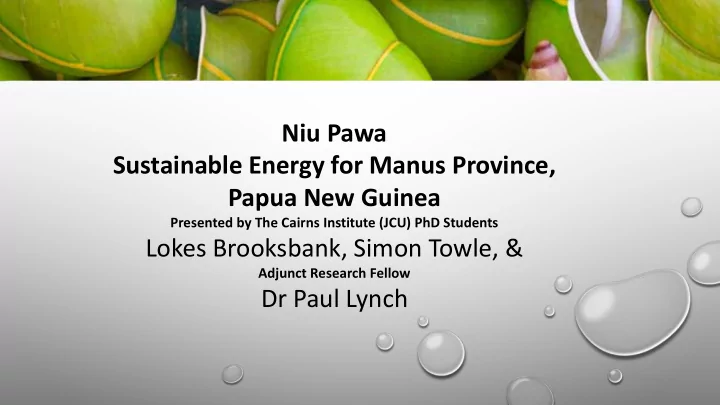

Niu Pawa Sustainable Energy for Manus Province, Papua New Guinea Presented by The Cairns Institute (JCU) PhD Students Lokes Brooksbank, Simon Towle, & Adjunct Research Fellow Dr Paul Lynch
Nigohern Aua & Wuvulu
Population 50,321 (2011 census) Population Growth Since 2000 0.7% Population Density 24 person/sq. Km Average Household Size 4.5 persons. Highest Population Lorengau Urban (15.1%) Land Mass 1,943 sq/k Sea Mass 461,693.4 sq/k Rainfall average 3,750 mm per annum Soil Type Volcanic, gravel sand, limestone, clay and large areas of low laying mangroves/swamps. Land Use Mainly for food crops farming. Areas of rubber, cocoa , vanilla in the inland area, and coconut all over the coastal areas and the outer islands.
Estimated cost and coconut oil production Levelised cost of electricity (LCOE) is a commonly used measure which reflects the average cost of electricity generation and can also be utilised to calculate the average minimum cost at which electricity can be sold (IEA, 2005). The LCOE considers lifetime costs to lifetime electricity generation such as maintenance, servicing, replacement of parts, fuel and initial capital investment costs (IEA, 2005; Cole & Banks, 2017). Specific cost analysis for coconut biofuels are not as readily available in comparison to solar and • wind, however a detailed study of coconut fuel in Fiji estimates LCOE of electricity generated using coconut oil to be $0.40 per kWh compared with $0.47 per kWh using solar technology alone. Data from literature focusing on Pacific suggests that on small Pacific islands coconut fuel could be produced at $0.70 per litre compared with diesel at $0.80 per litre equalling 12% less which would be reflected in LCOE calculations. A thousand mature coconuts weighing approximately 1,440 kilograms yield around 170 • kilograms of copra from which around 70 litres of coconut oil can be extracted (Bourke & Harwood, 2009). Referring to these figures, 70/170 = 0.14 litres of oil per kilo of copra, latest DPI estimates suggest that 200 tonnes of copra is currently being purchased on Manus Island, potential past DPI figures estimate that with operational plantations and small holding plots a median figure of 20,000 tonnes of copra be produced annually. 20, 000 tonnes = 820, 000 litres which is equal to 4,100, 200 litre barrels of coconut oil per year.
PRESENTATION REFERENCE SOURCES • SLIDE 1- Papustyla pulcherrima, Manus Green Shell, adapted from google images. • SLIDE 2 – Map of plantations locations, manus province PNG. Adapted from Department of Primary industries Papua New Guinea, 2010. • SLIDE 4 - Manus bio-fuels infrastructure, Towle, 2010. • SLIDE 7 - Copra Shed, adapted from DPI, 2010.
Recommend
More recommend